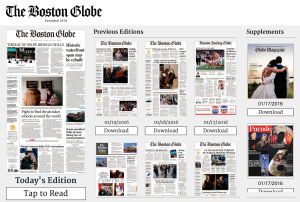
Thursday update: Significant second-day glitches. Shortly after 7 a.m., the most recent edition I could get was Wednesday’s. Then the app started telling me I needed an Internet connection, even though WiFi was working fine. Finally, a few minutes before 9, the problems seemed to be fixed.
Change isn’t always a disaster for The Boston Globe. This morning I clicked on the Globe‘s iPad app, which is based on a replica of the print edition. And the app was automatically overwritten by an entirely new version that looks much more like the ePaper available on BostonGlobe.com. It also seems to be a welcome improvement.
With the new app you can download the entire day’s paper (the only option with the previous version) or read it online. You can share articles on Twitter, Facebook, or other social networks, which represents a substantial upgrade. Tap on a story and it loads in a computer-friendly reading format. One refinement I’d like to see: when you click to make the type bigger, it should stay that way so that you don’t have to do it with each story.
The improvements aren’t dramatic, but overall the app feels more solid and complete.
The new version is also available for iPhone and, I suppose, those Android things as well. The previous version carried the miLibris brand; the new one is unbranded, though I see the company is still touting its relationship with the Globe. So maybe this is an improved miLibris product. (Or not; see update.)
The replica edition is not my favorite way of reading a newspaper. But BostonGlobe.com loads slowly on my iPad, and every so often I like to see what the paper looks like in print. Given the Globe‘s ongoing problems with home delivery, if you like print and have an iPad, you might want to give the new app a try.
Update: Former Globe digital guy Damon Kiesow reports that the new vendor is PageSuite:
https://twitter.com/dkiesow/status/689826261699555329


